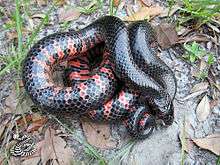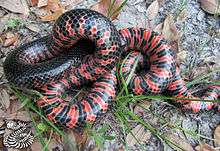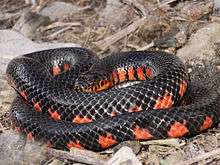Mud snake
The mud snake (Farancia abacura) is a species of nonvenomous, semiaquatic, colubrid snake endemic to the southeastern United States.[2]



| Mud snake | |
|---|---|
 | |
| Western mud snake, Farancia abacura reinwardtii, in Illinois | |
| Scientific classification | |
| Kingdom: | Animalia |
| Phylum: | Chordata |
| Class: | Reptilia |
| Order: | Squamata |
| Suborder: | Serpentes |
| Family: | Colubridae |
| Genus: | Farancia |
| Species: | F. abacura |
| Binomial name | |
| Farancia abacura (Holbrook, 1836) | |
| Synonyms[1] | |
| |
Description
The mud snake usually grows to a total length (including tail) of 40 to 54 inches (1-1.4 m),[3] with the record total length being slightly over 80 inches (2 m).[4]
The upperside of the mud snake is glossy black. The underside is red and black, and the red extends up the sides to form bars of reddish-pink.
The heavy body is cylindrical in cross section, and the short tail has a terminal spine.
The head scalation is distinctive in that there is only one internasal scale, no preocular scale, and one anterior temporal scale. The dorsal scales are smooth, and are arranged in 19 rows at midbody. There are 168-208 ventral scales and 31-55 subcaudal scales. The anal plate is divided.[5]
Habitat
F. abacura inhabits the edges of streams and cypress swamps, among dense vegetation or under ground debris. It is almost fully aquatic and rarely leaves the water, except to lay eggs, hibernate, or during drought to escape drying wetlands.[6][7]
Behavior
The mud snake is mostly aquatic and nocturnal. It preys mostly on giant aquatic salamanders in the genera Siren and Amphiuma, but it also eats other amphibians.[8] They are known to use their sharply pointed tails to prod prey items, leading to the nickname "stinging snake", although their tails contain no sting.
Reproduction
Breeding of F. abacura takes place in the spring, mostly in the months of April and May. Eight weeks after mating, the female lays 4 to 111[9] eggs in a nest dug out of moist soil, sometimes in alligator nests.[10] She will remain with her eggs until they hatch,[11] in the fall, usually September or October. Although unhatched eggs have not been found in the winter or spring, many juvenile mudsnakes are captured entering wetlands in the spring, most likely from clutches deposited and hatched in the preceding late summer or autumn. It is thought that mudsnake hatchlings either enter aquatic habitats in the autumn or delay entering them until the spring, but it is not known if they remain in a terrestrial nest or disperse into terrestrial habitats during this time.[12]
Geographic range
The mud snake is found in the southeastern United States, in the states of Alabama, Arkansas, Florida, Georgia, Illinois, Kentucky, Louisiana, Mississippi, Missouri, North Carolina, Oklahoma, South Carolina, Tennessee, Texas, and Virginia.[2]
Cultural significance
The mud snake is one of a few animals which may be the origin of the hoop snake myth. J.D. Willson writes:
Mud snakes are sometimes known as “hoop snakes” because of the myth that they will bite their own tail and roll after people.[2]
The hoop snake myth has also been attributed to the coachwhip snake.
Subspecies
There are two recognized subspecies of Farancia abacura, including the nominotypical subspecies:
- Farancia abacura abacura (Holbrook, 1836) - eastern mud snake
- Farancia abacura reinwardtii (Schlegel, 1837) - western mud snake
References
- Boulenger GA (1894). Catalogue of the Snakes in the British Museum (Natural History). Volume II., Containing the Conclusion of the Colubridæ Aglyphæ. London: Trustees of the British Museum (Natural History). (Taylor and Francis, Printers). xi + 382 pp. + Plates I-XX. (Farancia abacura, pp. 291-292).
- Willson JD (2006). Mud Snake (Farancia abacura) Archived 2011-09-02 at the Wayback Machine Savannah River Ecology Laboratory. Accessed April 23, 2011.
- Missouri Department of Conservation (2013). Western Mud Snake Archived 2011-09-07 at the Wayback Machine MDC Online. Accessed May 18, 2013
- The University of Georgia (2008). Mud Snake Archived 2011-09-29 at the Wayback Machine The University of Georgia: Museum of Natural History. Accessed April 23, 2011.
- Smith HM, Brodie ED Jr (1982). Reptiles of North America: A Guide to Field Identification. New York: Golden Press. 240 pp. ISBN 0-307-13666-3. (Farancia abacura, pp. 162-163.).
- Steen DA, Stevenson DJ, Beane JC, Willson JD, Aresco MJ, Godwin JC, Graham SP, Smith LL, Howze JM, Rudolph DC, Pierce JB, Lee JR, Gregory BB, Jensen J, Stiles SH, Stiles JA, Nazdrowicz NH, Guyer C (2013). "Terrestrial movements of the Red-bellied Mudsnake (Farancia abacura) and Rainbow Snake (F. erytrogramma)" (PDF). Herpetological Review. 44: 208–213.
- Willson JD, Winne CT, Dorcas ME, Gibbons JW (2006). "Post-drought responses of semi-aquatic snakes inhabiting an isolated wetland: insights on different strategies for persistence in a dynamic habitat" (PDF). Wetlands. 26: 1071–1078. doi:10.1672/0277-5212(2006)26[1071:prossi]2.0.co;2.CS1 maint: multiple names: authors list (link)
- Durso AM, Willson JD, Winne CT (2013). "Habitat influences diet overlap in aquatic snake assemblages" (PDF). Journal of Zoology (London). 291: 185–193. doi:10.1111/jzo.12061.
- Powell C, Stevenson DJ, Smith M, Jensen JB (2010). "A new clutch size record for the Mud Snake (Farancia abacura)". Southeastern Naturalist. 9: 177–178. doi:10.1656/058.009.0114.
- Hall PM, Meier AJ (1993). "Reproduction and behavior of western mud snakes (Farancia abacura reinwardtii ) in American alligator nests". Copeia. 1993: 219–222. doi:10.2307/1446314.
- Goin CJ, Goin OB, Zug GR (1978). Introduction to Herpetology, Third Edition. San Francisco: W.H. Freeman. xi + 378 pp. ISBN 0-7167-0020-4. ("Parental Care", Farancia abacura, p. 121).
- Semlitsch RD, Pechmann JH, Gibbons JW (1988). "Annual emergence of juvenile mud snakes (Farancia abacura) at aquatic habitats". Copeia. 1988: 243–245. doi:10.2307/1445944.
External links
- Species Farancia abacura at The Reptile Database
- Illinois Natural History Survey: Farancia abacura
- "Black Snakes": Identification and Ecology - University of Florida fact sheet
Further reading
- Behler JL, King FW (1979). The Audubon Society Field Guide to North American Reptiles and Amphibians. New York: Alfred A. Knopf. 743 pp., 657 color plates. ISBN 0-394-50824-6. (Farancia abacura, pp. 609-610 + Plate 492).
- Conant R (1975). A Field Guide to Reptiles and Amphibians of Eastern and Central North America, Second Edition. Boston: Houghton Mifflin. xviii + 429 pp. ISBN 0-395-19979-4 (hardcover), ISBN 0-395-19977-8 (paperback). (Farancia abacura, pp. 176–177 + Plate 25 + Map 138).
- Conant R, Bridges W (1939). What Snake Is That?: A Field Guide to the Snakes of the United States East of the Rocky Mountains. (With 108 drawings by Edmond Malnate). New York and London: D. Appleton-Century. Frontispiece map + viii + 163 pp. + Plates A-C, 1-32. (Farancia abacura, pp. 33–36 + Plate 3, Figure 7).
- Goldstein RC (1941). "Notes on the Mud Snake in Florida". Copeia. 1941 (1): 49–50. doi:10.2307/1437715.
- Holbrook JE (1836). North American Herpetology; or, A Description of the Reptiles Inhabiting the United States. Vol. I. Philadelphia: J. Dobson. 120 pp. (Coluber abacurus, new species, pp. 119–120).
- Meade GP (1937). "Breeding Habits of Farancia abacura in Captivity". Copeia. 1937 (1): 12–15. doi:10.2307/1437364.
- Morris PA (1948). Boy's Book of Snakes: How to Recognize and Understand Them. A volume of the Humanizing Science Series, edited by Jacques Cattell. New York: Ronald Press. New York. viii + 185 pp. ("The Mud Snake", Farancia abacura, pp. 87–88, 179).
- Powell R, Conant R, Collins JT (2016). Peterson Field Guide to Reptiles and Amphibians of Eastern and Central North America, Fourth Edition. Boston and New York: Houghton Mifflin Harcourt. xiv + 494 pp., 47 plates, 207 figures. (Farancia abacura, pp. i, 405-406 + Plate 39).
- Schlegel H (1837). Essai sur la physionomie des serpens. Amsterdam: M.H. Schonekat. Amsterdam. Partie Générale. xxviii + 251 pp. (Homalopsis reinwardtii, new species, p. 173). AND Partie Descriptive. 606 + xvi pp. (Homalopsis reinwardtii, pp. 357–358). (in French).
- Schmidt KP, Davis DD (1941). Field Book of Snakes of the United States and Canada. New York: G.P. Putnam's Sons. 365 pp. (Farancia abacura, pp. 106–108, Figure 22 + Plate 9).
- Wright AH, Wright AA (1957). Handbook of Snakes of the United States and Canada. Itahaca and London: Comstock. 1,105 pp. (in 2 volumes) (Farancia abacura, pp. 271–280, Figures 84-85, Map 25).
- Zim HS, Smith HM (1956). Reptiles and Amphibians: A Guide to Familiar American Species: A Golden Nature Guide. New York: Simon and Schuster. 160 pp. (Farancia abacura, pp. 75, 156).
